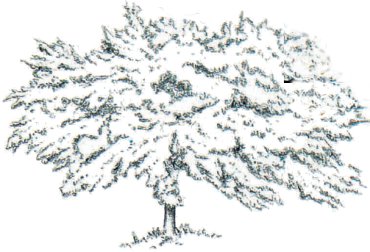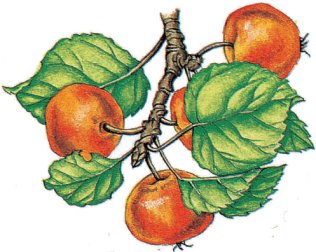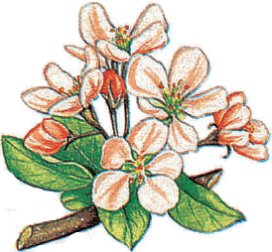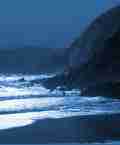
Crab Apple
Malus sylvestris
Crann-úll
 This small tree or large shrub up to 10 metres (32 feet) tall has a grey-brown scaly and fissured bark when mature and reddish brown twigs that are often spiny. Its leaves are oval and toothed, hairless when mature and up to 4 cm long. Its flowers are pink and white, 2 to 3 cm across. Its fruits are the familiar crab apples, yellowish green, sometimes flushed with red, only 2 or 3 cm broad and looking like typical but miniature apples. This small tree or large shrub up to 10 metres (32 feet) tall has a grey-brown scaly and fissured bark when mature and reddish brown twigs that are often spiny. Its leaves are oval and toothed, hairless when mature and up to 4 cm long. Its flowers are pink and white, 2 to 3 cm across. Its fruits are the familiar crab apples, yellowish green, sometimes flushed with red, only 2 or 3 cm broad and looking like typical but miniature apples.
 The native crab apple is widely distributed in Ireland, in hedges, woodlands and scrub, and is quite common in many districts. It occurs throughout Europe and reaches into south-western Asia. Its fruits are best in September or October and are used not raw as they are very bitter, but for making jelly (crab apple jelly sets quickly and easily), wine, cider and for a vinegar called verjuice that is used as one would lemon juice. The native crab apple is widely distributed in Ireland, in hedges, woodlands and scrub, and is quite common in many districts. It occurs throughout Europe and reaches into south-western Asia. Its fruits are best in September or October and are used not raw as they are very bitter, but for making jelly (crab apple jelly sets quickly and easily), wine, cider and for a vinegar called verjuice that is used as one would lemon juice. Crab apple wood is good for carving, having a very even texture and an attractive rosy brown colour. It was formerly used for making printing blocks and the heads of golf clubs.
 The cultivated apple is Malus domestica. It can be distinguished from the crab apple by its persistently hairy leaves and its flower stalks (pedicles) covered with woolly hairs. Although not native to Ireland, it is quite widely established in the wild, mainly in and around larger towns and cities, growing from pips in discarded apple cores The cultivated apple is Malus domestica. It can be distinguished from the crab apple by its persistently hairy leaves and its flower stalks (pedicles) covered with woolly hairs. Although not native to Ireland, it is quite widely established in the wild, mainly in and around larger towns and cities, growing from pips in discarded apple cores
Information extracted from the Appletree Press title
Appletree Deluxe Editions: Trees and Shrubs
by Peter Wyse-Jackson.
Appletree Deluxe Editions: Ireland's Flora & Fauna - Collection, comprising Trees and Shrubs, Birds of Ireland and Wild Flowers.
|




 This small tree or large shrub up to 10 metres (32 feet) tall has a grey-brown scaly and fissured bark when mature and reddish brown twigs that are often spiny. Its leaves are oval and toothed, hairless when mature and up to 4 cm long. Its flowers are pink and white, 2 to 3 cm across. Its fruits are the familiar crab apples, yellowish green, sometimes flushed with red, only 2 or 3 cm broad and looking like typical but miniature apples.
This small tree or large shrub up to 10 metres (32 feet) tall has a grey-brown scaly and fissured bark when mature and reddish brown twigs that are often spiny. Its leaves are oval and toothed, hairless when mature and up to 4 cm long. Its flowers are pink and white, 2 to 3 cm across. Its fruits are the familiar crab apples, yellowish green, sometimes flushed with red, only 2 or 3 cm broad and looking like typical but miniature apples. The native crab apple is widely distributed in Ireland, in hedges, woodlands and scrub, and is quite common in many districts. It occurs throughout Europe and reaches into south-western Asia. Its fruits are best in September or October and are used not raw as they are very bitter, but for making jelly (crab apple jelly sets quickly and easily), wine, cider and for a vinegar called verjuice that is used as one would lemon juice.
The native crab apple is widely distributed in Ireland, in hedges, woodlands and scrub, and is quite common in many districts. It occurs throughout Europe and reaches into south-western Asia. Its fruits are best in September or October and are used not raw as they are very bitter, but for making jelly (crab apple jelly sets quickly and easily), wine, cider and for a vinegar called verjuice that is used as one would lemon juice. The cultivated apple is Malus domestica. It can be distinguished from the crab apple by its persistently hairy leaves and its flower stalks (pedicles) covered with woolly hairs. Although not native to Ireland, it is quite widely established in the wild, mainly in and around larger towns and cities, growing from pips in discarded apple cores
The cultivated apple is Malus domestica. It can be distinguished from the crab apple by its persistently hairy leaves and its flower stalks (pedicles) covered with woolly hairs. Although not native to Ireland, it is quite widely established in the wild, mainly in and around larger towns and cities, growing from pips in discarded apple cores